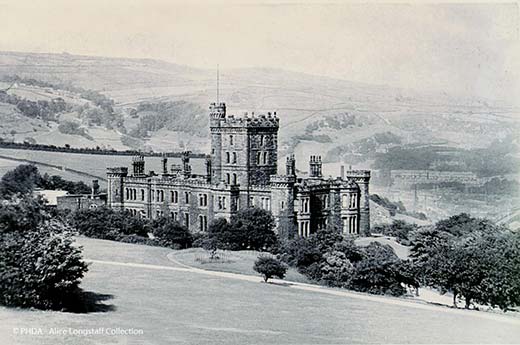Local History Society Report
The Fieldens and their legacy in Todmorden
Speaker: Anne Mealia
Thursday, 19 November 2020
The story of the Fieldens in Todmorden is one of rags to riches, Anne Mealia, local historian and genealogist, told her audience at the well-attended Zoom meeting of the Hebden Bridge Local History Society. There's hardly any aspect of life in 19th century Todmorden that the Fieldens didn't influence is some way, and their mark is found in the striking buildings that give the town much of its character.

The Fielden name is found in Todmorden from the sixteenth century and is still common today, and Anne pinpointed the growth of the family's fortunes to the decision by Joshua Fielden to move his business from Edge End Farm on the hillside, into the town itself. At Edge End Farm Joshua, like many other yeomen farmers, operated as a woollen manufacturer selling cloth in both Halifax and Manchester. He obviously saw an opportunity to make use of the newly opened turnpike road as well as abundant water supply when he bought three cottages at Laneside in 1782. In these cottages he installed spinning jennies and the business rapidly expanded with carding and weaving, moving to new premises along the road at Waterside mill (on the site of Morrison's supermarket). After Joshua's death the business passed to his sons and Fielden brothers became one of the biggest and most successful textile manufacturers with a reputation for good quality.
The success of textile manufacturing meant that the next generation of Fieldens had the security of capital, and made investments in the rising industries such as railways, gas and property development. Their business interests stretched way beyond Todmorden, to South America and New York. In a generation Fielden brothers had gone from three cottages to an international business.
The most famous Fielden is 'Honest' John, who became a Radical MP for Oldham, alongside William Cobbett. He had left school at ten and worked with his father Joshua, learning the business at first hand. He became a champion of a minimum wage for weavers, of the Ten Hour Act which limited child labour and a fierce opponent of the new Poor Law, which meant that Todmorden held out against establishing a Union Workhouse for thirty years. For many years he and his family had lived opposite the mill, at Dawson Weir, but he moved from the noise and bustle to a house which better reflected his wealth and status – Centre Vale.
He was also a strong supporter of Unitarianism, abandoning the Quaker faith of many of his forebears. He set up a Unitarian chapel, paying all the expenses of a minister, and after his death, his three sons – Samuel, John and Joshua - though following separate business paths, united to build a lavish new Unitarian church, bringing in celebrated architect John Gibson, who designed a stunning Gothic style building, with materials such as Sicilian marble and stained glass from Brussels no doubt helping to inflate the price from the planned £6000 to £36000.
John Gibson became the Fieldens' favourite architect, and when John Fielden junior wanted to build a castle on the hills for his bride, Gibson presented him with Dobroyd Castle. Its Gothic exterior of local stone contrasts with a classical interior again using the most opulent materials. The so-called 'Brass Castle' (designed to show off new wealth) was not a home to Fielden and his wife for long though. In the latter part of the century John and his second wife tried to fight the scourge of drunkenness by establishing a Coffee Tavern and Temperance Hotel, next to the Golden Lion, offering smoking and billiards along with sarsaparilla and the mysteriously named 'Che-oak' herbal tonic. The people of Todmorden clearly didn't flock there and it closed within a few years.
John Gibson's architecture continued to shape Todmorden, with the magnificent and imposing Todmorden Town Hall glorifying the industry of the valley town. John's brother Joshua employed Gibson to extend Stansfield Hall with the addition of a billiard room, ballroom, gatehouse and a row of new cottages to block out an unsightly view. When Joshua left the town to head south, he commissioned Gibson to create the lavish Nutfield Priory in Surrey.
The eldest of the three brothers, Samuel, stayed in Todmorden and died one of the richest men in England. He inherited the house at Centre Vale, which Gibson was again set to redesign, including creating the extensive gardens. Samuel was a supporter of cricket in the town, setting aside some land for a cricket pitch. His wife Sarah was also a philanthropist, setting up a school for girls at Fielden school (also designed by Gibson and now Fielden Hall). After her death the building was given to the town with the stipulation that it be used for educational purposes. Centre Vale house succumbed to dry rot and was demolished in the 1950s.
As the textile business was no longer an important source of wealth, the later generations of Fieldens tended to move away from Todmorden. What they saw around them was 'damp, dirty and dull' contrasting with the magnificent buildings that they left behind from a time when they had dominated the life of the town. Anne's researches into the family brings them back into clearer focus.
The next talk for Hebden Bridge Local History Society will be on Wednesday 25th November at 7.30. Anne Kirker will be telling us about Laura Annie Wilson: suffragette, builder and engineer. All the current programme of lectures will be delivered as Zoom webinars and non-members are welcome to sign up for these.
Details of the talks programme, publications and of archive opening times are available on the Local History Society website and you can also follow the Facebook page.
With thanks to Sheila Graham for this report
See also

